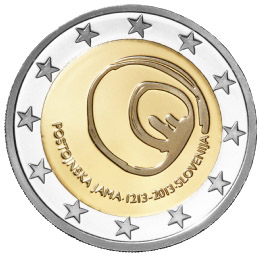Numismatics
- 150th anniversary of Josip Plemelj's birth
- 35th anniversary of the Erasmus programme
- 150th anniversary of the birth of architect Jože Plečnik
- 500th anniversary of the birth of Adam Bohorič (2020)
- Centenary of the founding of the University of Ljubljana (2019)
- 200th anniversary of the founding of the Provincial Museum for Carniola, the first museum in Slovenia (2021)
- World Bee Day (2018)
- 10th anniversary of the introduction of the euro in Slovenia (2017)
- 25th anniversary of independence of the Republic of Slovenia (2016)
- 30th anniversary of the European Union flag (2015)
- Emona – Ljubljana (2015)
- 600th anniversary of the coronation of Barbara of Celje (2014)
- 800th anniversary of visits to Postojna Cave (2013)
- 10th anniversary of Euro Cash (2012)
- 100th anniversary of the birth of the national hero Franc Rozman – Stane (2011)
- 200th anniversary of the Botanic Gardens in Ljubljana (2010)
- 10th Anniversary of the Economic and Monetary Union (2009)
- 500th anniversary of the birth of Primoz Trubar (2008)
- 50th anniversary of the Treaty of Rome (2007)
800th anniversary of visits to Postojna Cave (2013)
Postojna Cave, Slovenia's most remarkable natural sight and the most visited show cave in Europe is one of the most beautiful caves, and one of the richest in terms of cave formations or 'speleothems'. In prehistoric times people used the cave as a refuge. Later, the local inhabitants enjoyed showing visitors the cave's entrance passages and chambers, where they would sign their names on the calcite-covered walls and speleothems. Signatures discovered in the Passage of Old Signatures date from as far back as the 13th century. The very oldest of them is from 1213. This last signature is believed to have been made using charcoal, lead or red stone. A tracing of the signature was made by Alois Schaffenrath, who from 1825 to 1836 served as imperial and royal district engineer at the district government office in Postojna and was the technical director of the Cave Commission, the administrative body of Postojna Cave at that time. He also made 12 copper engravings (1830–1832), which served as an appendix to the bookTravellers' Guide to the Renowned Postojna Cave and the Cave of Crown Prince Ferdinand in Postojna, Carniola.
Organised visits to the cave are considered to have begun in 1819, when Ferdinand, heir to the Austrian throne, became the first person to sign the visitors' book and visit the newly discovered sections of the cave. The development of tourism in Postojna Cave was rapid: railway tracks were laid in 1872 and the cave has been illuminated by electric lights since 1883.
Today Postojna Cave receives more than half a million visitors each year. To date the cave has been admired by more than 34 million people, who have carried its name and their impressions of it around the world.
Source: Postojna Cave
Commemorative coin
The Republic of Slovenia is issuing a commemorative coin to mark the 800th anniversary of the first recorded visit to Postojna Cave, depicting a stylised spiral ending in two speleothems. The spiral represents the length and age of the cave, and at the same time indicates the path that has led visitors into the cave for 800 years.
Original design: Matevž Zalar, Šmarje Sap / Slovenia.
Minting: Mincovna Kremnica, š.p., Kremnica / Slovakia.
- Minted: 1 million coins.
- Date of issue: 4 February 2013.
Official Journal of the EU, C23/10 - 25. 1. 2013.
Commemorative coin in plastic capsules
The Bank of Slovenia has prepared a special €2 proof commemorative coin issued to mark the 800th anniversary of visits to Postojna Cave:
- 8,000 coins in plastic capsules.
They are on sale from 4 February 2013.
The list of Banka Slovenije's numismatic products and their availability as well as their price can be found at the following web page.


